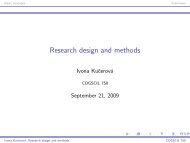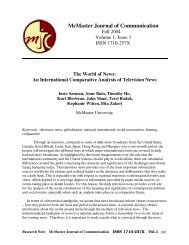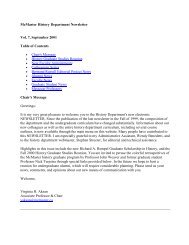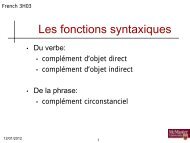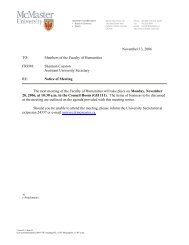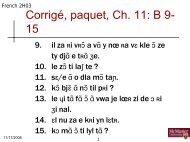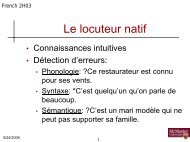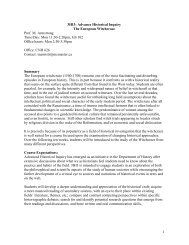The Syntax of Givenness Ivona Kucerová
The Syntax of Givenness Ivona Kucerová
The Syntax of Givenness Ivona Kucerová
Create successful ePaper yourself
Turn your PDF publications into a flip-book with our unique Google optimized e-Paper software.
(40) What happened to the antique chair you got many years ago from Mary?<br />
a. Můj bývalý partner se pokusil tu židli<br />
my former partner REFL tried that chair<br />
‘My ex-partner tried to burn the chair.’<br />
b. Můj bývalý partner chtěl tu židli spálit .<br />
my former partner wanted that chair burn.Inf<br />
‘My ex-partner wanted to burn the chair.’<br />
c. Můj bývalý partner dokázal tu židli spálit .<br />
my former partner managed that chair burn.Inf<br />
‘My ex-partner managed to burn the chair.’<br />
d. #Tu židli můj bývalý partner dokázal spálit .<br />
that chair my former partner managed burn.Inf<br />
spálit .<br />
burn.Inf<br />
‘My ex-partner managed to burn the chair. (OK: As to the chair, my expartner<br />
managed to burn it.)’<br />
If we do not bind G-movement to head movement, this behavior is unexpected also because<br />
other elements, for example clitics, can climb up from the infinitival domain as in (41) with<br />
a reflexive tantum posadit se ‘sit down’.<br />
(41) a. Petr se chtěl posadit .<br />
Petr.Nom REFL wanted sit-down<br />
‘Petr wanted to sit down.’<br />
b. Petr se dokázal posadit<br />
Petr.Nom REFL managed sit-down<br />
‘Petr managed to sit down.’<br />
.<br />
If we assume that infinitives that allow clitic climbing are restructuring verbs (cf. Dotlačil<br />
2004; Rezac 2005), then the infinitival restriction on G-movement cannot follow from presence<br />
<strong>of</strong> a phase boundary. Whatever allows the clitic to get to the main clause, should be<br />
able to get the given element out as well. 19 As we can see, however, this is not so. On the<br />
other hand, if we allow G-movement <strong>of</strong> α G to take place only if the relevant head moves as<br />
well, the difference between clitics and given material is predicted.<br />
Furthermore, we predict that if a verbal head is selected by another verbal head (an<br />
auxiliary), G-movement should be blocked as well. We find a useful minimal pair if we<br />
compare sentences in the Present or the Past tense with sentences in the Future tense. <strong>The</strong><br />
main verb in the future tense, in contrast to other tenses where the verb moves out <strong>of</strong> VP,<br />
stays in VP and the future auxiliary is base generated in vP (Veselovská, 2004; Kučerová,<br />
2005). As we can see in (42), (43), and (44), the difference in the different head movement<br />
properties, especially lack <strong>of</strong> head movement in the Future tense, propagates to the domain<br />
in which an element can undergo G-movement. While in (42) and (43) the verbal head is<br />
free to move and the given object can therefore G-move, in (44) the given object can only<br />
19 Clitic climbing in Czech is a syntactic, not a phonological, process. This can be shown, for example, by<br />
the fact that different clitics in Czech climb differently. See Dotlačil 2004 for more details.<br />
27





